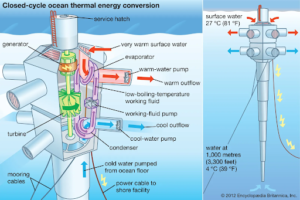In news– Recently, the Union Minister of State (Independent Charge) Earth Sciences stated that an Ocean thermal energy conversion plant is coming up in Lakshadweep.
About the plant & OTEC technology-
- OTEC is a form of energy conversion that makes use of the temperature differential between the warm surface waters of the oceans, heated by solar radiation, and the deeper cold waters to generate power in a conventional heat engine.
- The National Institute of Ocean Technology, an autonomous institute under the Union Ministry of Earth Sciences (MoES) is establishing OTEC plant with a capacity of 65 kilowatt (kW) in Kavaratti, the capital of Lakshadweep.
- The plant will power the one lakh litre per day low temperature thermal desalination plant, which converts seawater into potable water.

- The current OTEC project is being set up to power a desalination plant. The power expected to be generated is under 200 kW.
- India is geographically well-placed to generate ocean thermal energy, with around 2000 kms of coast length along the South Indian coast, where a temperature difference of above 20oC is available throughout the year.
- The total OTEC potential around India is estimated as 180,000 MW, considering 40% of gross power for parasitic losses.
- The OTEC concept was first proposed in the early 1880s by the French engineer Jacques-Arsène d’Arsonval.
- His idea called for a closed-cycle system, a design that has been adapted for most present-day OTEC pilot plants.
- Such a system employs a secondary working fluid (a refrigerant) such as ammonia.
- Heat transferred from the warm surface ocean water causes the working fluid to vaporize through a heat exchanger.
- The vapour then expands under moderate pressures, turning a turbine connected to a generator and thereby producing electricity.
- Cold seawater pumped up from the ocean depths to a second heat exchanger provides a surface cool enough to cause the vapour to condense. The working fluid remains within the closed system, vaporizing and reliquefying continuously.
















